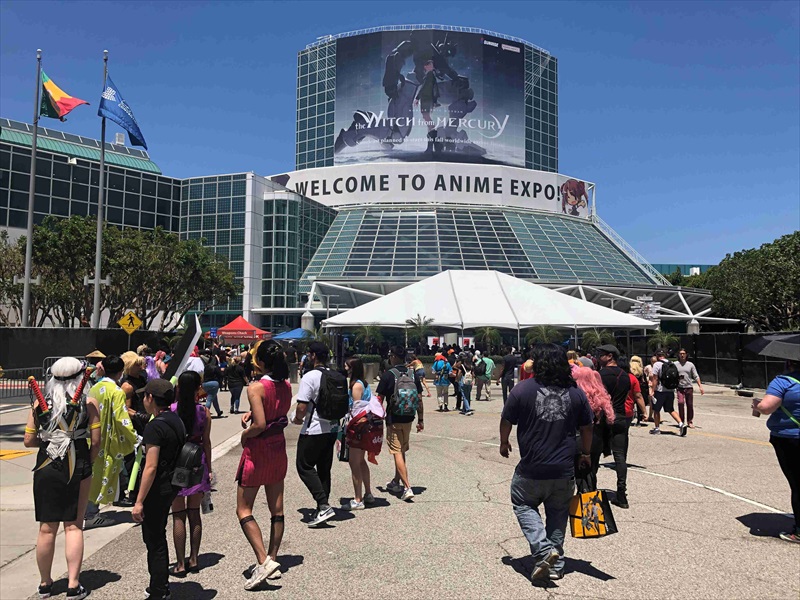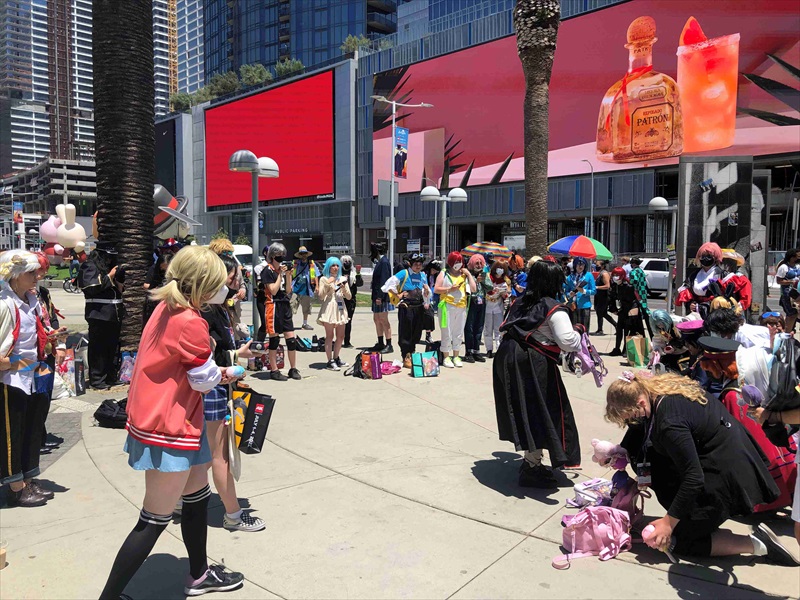<Report from overseas office> [The U.S.]The Potential and Challenges of the Japan Contents Business as Observed at the LA Anime Expo, the Largest Anime Expo in the U.S.


Photo: Taken by the author outside the venue
How to enjoy Anime Expo in an American way
The first thing that struck me when I was at the event was the overwhelming percentage of young people in their teens and twenties who gathered at the venue, all dressed in their favorite cosplay and looking like they were having a great time, and the venue was filled with the positive enthusiasm of the full house.
Compared to Japan, the U.S. Anime Expo is probably more like an anime event, cosplay event, and comic market all rolled into one.
As there is no registration system for cosplayers like at major events in Japan, participants range from high quality cosplayers to casual cosplayers, and everyone from young people to children enjoy themselves. I thought this was an event that was very typical of American youth. In a word, it is like a Japan Anime version of Halloween.
The long line at the check-in counter for cosplayers who brought their own weapons as a prop was also very American. It probably took more than an hour for cosplayers with weapons to enter.
*For copyright and portrait rights reasons, we are unable to post photos of the venue, but we will post a summary video from the official website for your reference. (Please note that audio will also be played.)
Source:https://www.facebook.com/animeexpo
Why is Japanese animation so popular in the U.S. today?
I think it is fair to say that Japanese anime is booming the biggest in the United States in past couple of years.
Of course, world-famous anime content such as Dragon Ball and Gundam have always had many fans in the U.S., but the recent anime fan trend is very different in several ways.
One of the most influential is that the expansion of subscription services such as Netflix, Crunchyroll, etc., has greatly increased the viewing rate of anime.
I think it is fair to say that "Anime" is now an established English word for Japanese anime.
Due to COVID, Americans are spending more time watching subscriptions programs, and in this context, anime is gaining the support of young people who want to watch more than just typical American content.
Furthermore, now that the same anime that is broadcast in Japan can be enjoyed in the U.S. in almost real time with English dubbing, the time gap between American and Japanese fans is disappearing, which is another feature that is different from the past.
We are now in a transitional period in which the position of Japanese anime in the U.S. is changing from a culture of a few otaku to a more general youth culture.
Possibilities and Challenges of Animation as a Content Business
This year's LA Anime Expo is being held with the participation of a variety of major and small Japanese anime-related companies, as well as the full support of the Japanese Cultural Center of Japan. What started out as a small gathering of California anime fans has grown into one of the major events representing LA culture.
As a marketer living in the U.S., I am very happy to see Japanese content gaining so much support from American youth, but on the other hand, I also feel that it is a shame to not use it well, because the potential is so great.
The marketing direction of Anime Contents can be broadly divided into two aspects: outbound and inbound.
In terms of outbound marketing, despite the great potential of anime content, its ability to communicate to the U.S. market is weak.
For example, looking at Korean content, movies such as Parasite, dramas such as Squid Game, and music content such as KPOP are promoted in large numbers to media outlets and events that are regularly watched by Americans, resulting in synergistic effects among these media outlets and events. As a result, the synergistic effect of each of these activities has resulted in the increase in recognition of Korean content in the U.S..
On the other hand, Japanese content, such as anime, games, movies, and TV programs, which are the strong points of Japanese content, are promoted individually and do not reach most Americans. I feel that the Japanese content is not being strategically promoted on a large scale and is lacking.
For this reason, the current anime boom in the U.S. is largely due to the spread of Netflix, and it is difficult to say that it is the result of an outbound strategy initiated from the Japanese side.
In terms of inbound tourism, despite the popularity of anime among young people, Japan has not yet established a mechanism to accept this Anime boom and utilize it as inbound content.
For example, if there were large events and facilities where overseas anime fans could enjoy shopping and cosplaying in peace, more people would visit Japan for this purpose. However, the hurdles for overseas visitors to participate in anime events are high.
We believe that it should be recognized that there is more interest and need for JAPAN anime and game events for young people overseas than for traditional old-school Expos and sporting events.
The current popularity of Japanese animation in the U.S. and around the world is the greatest opportunity for the public and private sectors to work together to develop the animation industry and make it a pillar of Japan's content business in the future.
We, as local researchers, would like to help by providing information on local trends and proposing marketing strategies.
-

Author profile
(Mr.) Masashi Sunazuka
Researcher living in Los Angeles, USA. While being surprised and bewildered by the adventurous spirit and diversity of the U.S., where new products, services, and trends are born one after another, I always experience things with curiosity myself and provide real information about the U.S. today from a Japanese perspective.
-

Editor profile
Intage Inc.
***
- Jul 15, 2022
- 3070 Views
 Global Market Surfer
Global Market Surfer CLP
CLP